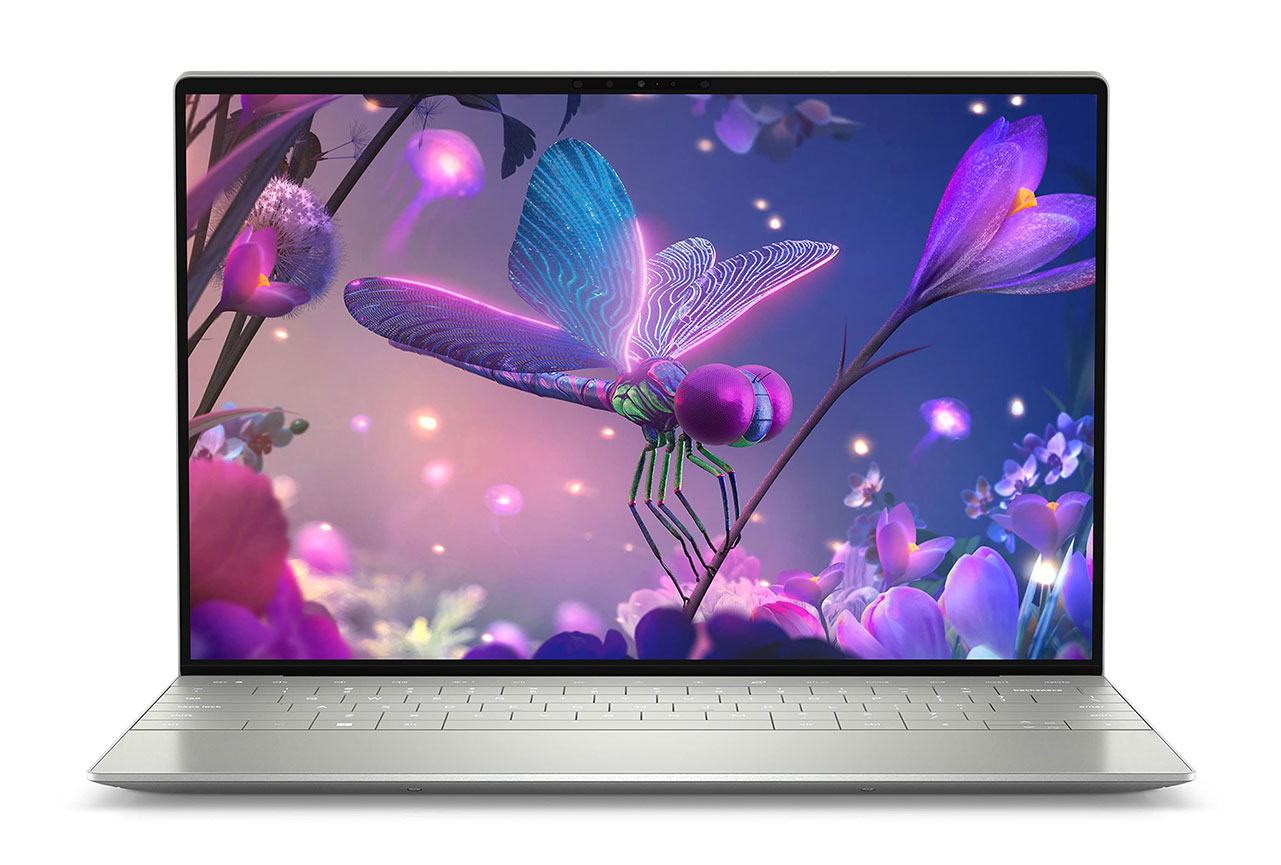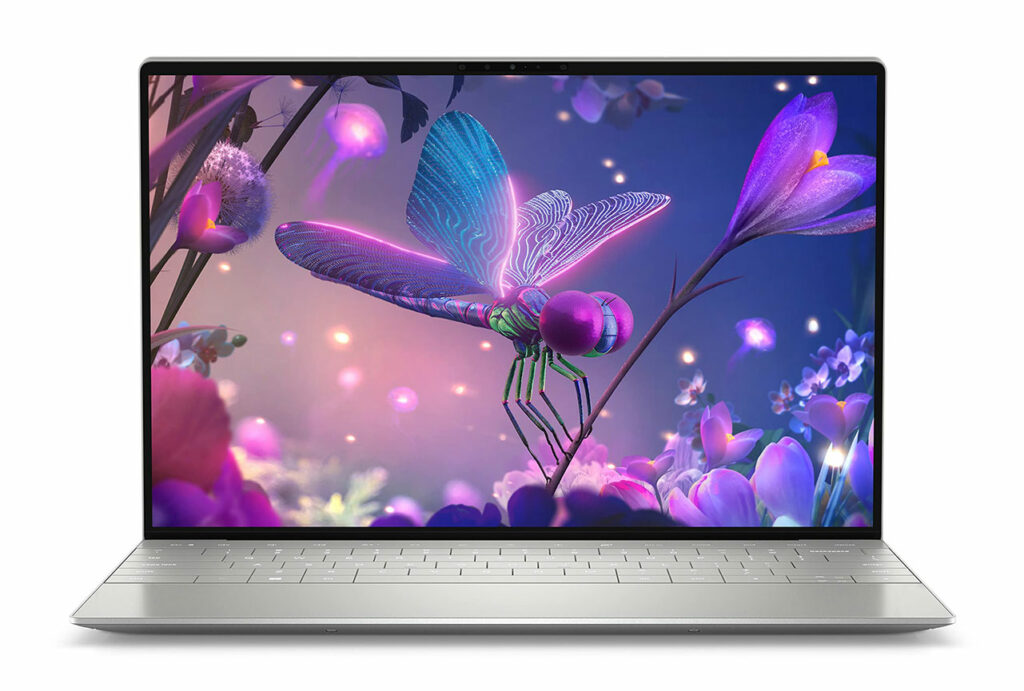We put the Dell XPS 13 Plus (2023) through our rigorous DXOMARK Laptop test suite to measure its performance both at sound, camera and display.
In this review, we will break down how it fared in a variety of tests and several common use cases.
Overview
Key specifications include (as given by the manufacturer):
- Physical specs : 29.53×19.90×1.53
- Display : 3840×2400 OLED, 60 Hz, 500 nits, Touch
- Audio : Stereo 2x2W Speakers
- Webcam : HD 720p 30fps
Scoring
Use-case and feature subscores included in the calculations of the global score
 Dell XPS 13 Plus (2022)
Dell XPS 13 Plus (2022)

83
camera
60
Apple MacBook Pro 14" (M3 Pro, 2023)
Best: Apple MacBook Pro 14" (M3 Pro, 2023) (93)
28
Lenovo ThinkPad X9 Aura
Best: Lenovo ThinkPad X9 Aura (56)
54
Apple MacBook Pro 14" (M3 Pro, 2023)
Best: Apple MacBook Pro 14" (M3 Pro, 2023) (76)
63
Apple MacBook Pro 14" (M2 Pro, 2023)
Best: Apple MacBook Pro 14" (M2 Pro, 2023) (83)

121
display
65
Apple MacBook Pro 14" (M3 Pro, 2023)
Best: Apple MacBook Pro 14" (M3 Pro, 2023) (84)
52
Apple MacBook Pro 14" (M3 Pro, 2023)
Best: Apple MacBook Pro 14" (M3 Pro, 2023) (95)
69
Honor MagicBook View 14 (2022)
Best: Honor MagicBook View 14 (2022) (84)

125
audio
123
Apple MacBook Pro 14" (M2 Pro, 2023)
Best: Apple MacBook Pro 14" (M2 Pro, 2023) (149)
126
Acer Swift Go 14
Best: Acer Swift Go 14 (133)
112
Asus Zenbook 14X OLED (2023)
Best: Asus Zenbook 14X OLED (2023) (153)
Pros
- In video calls, strong underexposure on faces during video calls in high dynamic scenes
- In video calls, limited dynamic range on camera
- Good overall voice intelligibility in video calls
Cons
- In video calls, background sounds can still be heard in the captured audio, strongly impacting the experience
- In video calls, duplex issues leading to voice intelligibility limitations in double talk situations
- Below average SDR performance
- While watching HDR contents, gamut and maximum brightness are limited, and highlights are easily clipped
- Too high minimum brightness
- Noticeable distortion in multimedia playback at loud volumes
- In Music & Video, below average timbre rendition with aggressive treble, lack of bass and low midrange
The Dell XPS 13 Plus (2023) put in a well-balanced but only average overall performance across all features and use cases for audio, camera, and display. Its audio performance was more suited to video calls than to multimedia use cases.
Test summary
About DXOMARK Laptop tests: For scoring and analysis in our laptop reviews, DXOMARK engineers perform a variety of objective tests and undertake more than 20 hours of perceptual evaluations under controlled lab conditions and real-life scenarios.
(For more details about the Laptop protocol, click here.)
The following section gathers key elements of our exhaustive tests and analyses performed in DXOMARK laboratories. Detailed performance evaluations under the form of reports are available upon request. Do not hesitate to contact us.
Dell XPS 13 Plus (2023) overall & use-cases scores
Video Call
122
Apple MacBook Pro 14" (M2 Pro, 2023)
Apple MacBook Pro 14" (M2 Pro, 2023)
About DXOMARK Laptop tests
DXOMARK's Video call use case is a score that evaluates how a device handles video calls and videoconferencing in multiple conditions. This score focuses on the camera performance and the capture and playback rendering of voices. Read more about how we test the use cases of Video call score here.
The Dell laptop’s camera had low texture performance and did not handle noise well. Further, it had limited dynamic range, and faces were very underexposed in high dynamic scenes. Its audio system did better, with good voice timber and intelligibility. However, its SNR was poor, as background noise could be heard in captured audio; moreover, gating impaired intelligibility when more than one person was talking.
Camera
83
Apple MacBook Pro 14" (M3 Pro, 2023)
Apple MacBook Pro 14" (M3 Pro, 2023)
The following chart presents the camera subscores for the video call use case:
Camera texture acutance on Deadleaves with illuminance levels
This graph shows the evolution of texture acutance with the level of lux measured on a Deadleaves chart.
The following graphs show the objective measurements performed in our camera labs:
Camera visual noise evolution with illuminance levels
This graph shows the evolution of spatial visual noise with the level of lux. Spatial visual noise is measured on the visual noise chart in the video noise setup. DXOMARK visual noise measurement is derived from ISO15739 standard.
Target exposure on face with illuminance levels
These measurements take place on a setup combining realistic mannequins and a backlit panel simulating high dynamic range conditions. This graph shows the evolution of lightness measured on the forehead of the realistic mannequin with the level of lux, for multiple lighting conditions. The lightness is measured in L*. Delta EV specifies the difference of luminance in stops between the face and the light panel simulating HDR conditions.
Target exposure on face with illuminance levels in HDR conditions
These measurements take place on a setup combining realistic mannequins and a backlit panel simulating high dynamic range conditions. This graph shows the evolution of lightness measured on the forehead of the realistic mannequin with the level of lux, for multiple lighting conditions. The lightness is measured in L*. Delta EV specifies the difference of luminance in stops between the face and the light panel simulating HDR conditions.
Target exposure on face with illuminance levels in HDR conditions
These measurements take place on a setup combining realistic mannequins and a backlit panel simulating high dynamic range conditions. This graph shows the evolution of lightness measured on the forehead of the realistic mannequin with the level of lux, for multiple lighting conditions. The lightness is measured in L*. Delta EV specifies the difference of luminance in stops between the face and the light panel simulating HDR conditions.
Audio
131
Apple MacBook Pro 14" (M2 Pro, 2023)
Apple MacBook Pro 14" (M2 Pro, 2023)
The following chart presents the capture subscores for the video call use case:
Audio capture scores comparison
The following graphs show the frequency response, distortion and directivity in capture, recorded in our semi-anechoic room:
Audio capture frequency response
A 1/12 octave frequency response graph, which measures the volume of each frequency captured by the laptop when recording an objective test signal at 1 meter in an anechoic environment.
Audio capture Total Harmonic Distortion + Noise
This graph shows the Total Harmonic Distortion and Noise over the hearable frequency range. It represents the distortion and noise of the device capturing our test signal.
Audio capture directivity
Directivity graph of the laptop microphone(s) when capturing test signals using the camera app. It represents the acoustic energy (in dB) over the angle of incidence of the sound source (normalized to the angle 0°, in front of the device).
About DXOMARK Laptop tests
DXOMARK's Video and Music use case score evaluates the capability of a device to reproduce multimedia usages such as videos, movies and music playback in indoor conditions. This score focuses on the display performance and audio-playback rendering. Read more about how we test this use case here.
The Dell’s display performance when dealing with SDR content was below average, with desaturated blues and magentas, and slightly raised blacks. Although the laptop can display HDR content, its gamut and maximum brightness were limited compared to other HDR-capable devices. At 27 nits, its minimum brightness was quite high, which may be bothersome when using the laptop in low light.
Overall timbre rendition for multimedia was below average, with aggressive trebles, and lack of bass and low midrange. Some resonances introduced disturbing hissing and noticeable distortion. Temporal compression impaired the Dell’s dynamics performance, with losses of attack, punch, and bass precision. Distortion in multimedia playback was particularly audible at loud volumes.
The following chart presents the display subscores for the multimedia use case:
Display scores comparison
The following graphs show the objective measurements performed in our display lab:
Display gamut coverage for video contents
The primary colors are measured both in HDR10 and SDR. The extracted color gamut shows the extent of the color area that the device can render. To respect the artistic intent, the measured gamut should match the master color space of each video.
Display reflectance measurement (SCI)
Measurements above show the reflection of the device within the visible spectrum range (400 nm to 700 nm). It includes both diffuse and specular reflection.
Display reflectance profile
Display brightness uniformity
0.867
cd/m²
0.814
cd/m²
0.835
cd/m²
0.915
cd/m²
0.878
cd/m²
0.84
cd/m²
0.832
cd/m²
0.803
cd/m²
0.811
cd/m²
 Distribution of brightness (min)
Distribution of brightness (min)
424.2
cd/m²
405.9
cd/m²
407.4
cd/m²
447
cd/m²
431.8
cd/m²
434.6
cd/m²
419.1
cd/m²
418.2
cd/m²
414.8
cd/m²
 Distribution of brightness (max)
Distribution of brightness (max)
This illustration shows the brightness measured on nine zones of the display for minimum brightness (left) and maximum brightness (right) for SDR content.
Display SDR EOTF measurement
This graph represents the rendering of contrast (gray levels) for SDR video content, measured in the dark. We expect to be close to the 2.2 or 2.4 gamma references.
Display peak brightness for video contents
Display white point
This graph represents the color temperature of white content, compared with the reference (Daylight illuminant D65) measured in the dark on video at minimum and maximum brightness.
The following chart presents the playback for the multimedia use case:
Audio playback scores comparison
The following graphs show the frequency response, distortion and directivity in multimedia playback, recorded in our semi-anechoic room:
Audio playback frequency response
A 1/12 octave frequency response graph, which measures the volume of each frequency emitted by the laptop when playing a pure-sine wave in an anechoic environment.
Audio playback Total Harmonic Distortion + Noise



 Distribution of brightness (min)
Distribution of brightness (min)
 Distribution of brightness (max)
Distribution of brightness (max)





DXOMARK encourages its readers to share comments on the articles. To read or post comments, Disqus cookies are required. Change your Cookies Preferences and read more about our Comment Policy.